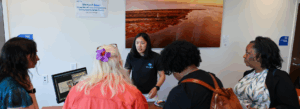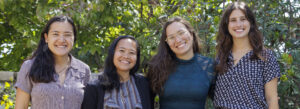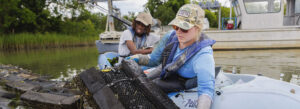VASG fellows lead oyster harvest activity for Hampton University STEM series
Usually, when researchers lead a school activity about oysters, they’d bring students to the lab to dissect an oyster or demonstrate how oysters can filter water. But since in-person gatherings weren’t possible, graduate students Kaitlyn Clark and Annie Schatz got creative while teaching a Hampton University TRiO Educational Talent Search lesson. The Educational Talent Search program, which serves more than 800 students each year, provides activities for students who are underrepresented in postsecondary education.
The two adapted a NOAA education lesson that showed how oyster harvests have changed over the years, from original methods used by indigenous Americans all the way to modern-day power dredges — and compared how each method affected oyster reefs.
“I was excited we were able to find a lesson that allowed us to still talk about the oyster fishery, but was creative — we used beans to represent the oyster reef,” said Clark, a master’s student at the Virginia Institute of Marine Science and a Virginia Sea Grant Graduate Research Fellow.
The group of 20 middle school and high school students used household items like forks, pencils, spoons, and measuring cups to scrape oysters off the “reef” of dried beans in 10-second rounds that mimicked harvest seasons. After each round, students counted the oyster harvests and observed how each tool affected the reef structure.
Starting with chopsticks that plucked single oysters off the mound — similar to the “nippers” used in the Chesapeake Bay as early as the 1600s. Then students tried hand-tongs, simulated by raking oysters off the reef by holding two forks together.
Diamonique Merilan, an eighth grader in Hampton, said the chopstick “nippers” were the most challenging harvest method, and the activity “really got me thinking about the oysters in the Chesapeake Bay.”
“They used these rakes or scissor things to collect them off [the reef],” Merilan said. “I was like, ‘Well, that seems pretty inefficient.’”
Newer technologies like dredges — a metal basket dragged along the bottom to collect oysters — allowed for a more efficient harvest. Motorized boats made dredging even more effective, which the activity simulated by using a larger spoon to represent the dredge. But these harvest methods also caused more damage to the reef structure — and students recorded how much each method changed reef.
While students were counting, Clark and Schatz shared more about the decline of oysters in the bay from disease and overharvesting. When oysters were plentiful, shells were used to pave roads, make plaster, and scattered as fertilizer in the early 1900s. More recently, restoration and aquaculture have helped oyster reefs recover.
“It really got me thinking about the oysters in the Chesapeake Bay,” Diamonique Merilan said.
By hosting events like the STEM Saturday oyster harvest activity, the program helps students learn about opportunities beyond high school and how to prepare for them.
The activity also allowed Clark and Schatz to share their career paths in marine science, and the different ways for students to learn more about marine science beyond the Saturday activity.
“For a Saturday morning, it was really exciting how engaged the students were,” Schatz, a Ph.D. student at VIMS, said. “I was just excited they were asking questions.”
The Educational Talent Search program provides activities for students who are underrepresented in postsecondary education. By hosting events like the STEM Saturday oyster harvest activity, the program helps students learn about opportunities beyond high school and how to prepare for them.
“That is one of the great disparities for kids — that their parents don’t know the opportunities that are available,” said Marianne Merilan, whose daughter participated in the oyster activity. “You just have to look for them. I didn’t have a lot of these [growing up], so when I became a parent, I did everything I could to look for these programs.”
More information about applying for the TRiO Educational Talent Search program at Hampton University can be found here.
Takeaways:
- To show junior high and high school students how oysters are harvested in the Chesapeake Bay, two Graduate Research Fellows created a lesson about the history of oysters in the region.
- Using household items like chopsticks, forks, and spoons, students simulated different harvest methods on an oyster “reef” made of beans. They tracked how efficient each method was and the effect on the reef’s structure.
- The activity, part of Hampton University’s TRiO Educational Talent Search program, engages students who are underrepresented in postsecondary education.
Contributed Photo by Annie Schatz and Kaitlyn Clark
Photos and Video by Aileen Devlin | Virginia Sea Grant
Published March 19, 2021.
“That is one of the great disparities for kids — that their parents don’t know the opportunities that are available,” said Marianne Merilan.





